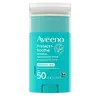What's inside
What's inside
 Key Ingredients
Key Ingredients

 Benefits
Benefits

 Concerns
Concerns

 Ingredients Side-by-side
Ingredients Side-by-side

Water
Skin ConditioningIsohexadecane
EmollientC12-15 Alkyl Benzoate
AntimicrobialEthylhexyl Methoxycrylene
Skin ConditioningBehenyl Alcohol
EmollientSteareth-21
CleansingGlyceryl Stearate
EmollientPEG-100 Stearate
Calcium Aluminum Borosilicate
Euphorbia Cerifera Wax
Polyhydroxystearic Acid
EmulsifyingCetyl Alcohol
EmollientTriethoxycaprylylsilane
Aluminum Hydroxide
EmollientXanthan Gum
EmulsifyingStearic Acid
CleansingPhenoxyethanol
PreservativeEthylhexylglycerin
Skin ConditioningGlycerin
HumectantChlorphenesin
AntimicrobialTocopheryl Acetate
AntioxidantDisodium EDTA
Aloe Barbadensis Leaf Extract
EmollientAvena Sativa Kernel Extract
AbrasiveWater, Isohexadecane, C12-15 Alkyl Benzoate, Ethylhexyl Methoxycrylene, Behenyl Alcohol, Steareth-21, Glyceryl Stearate, PEG-100 Stearate, Calcium Aluminum Borosilicate, Euphorbia Cerifera Wax, Polyhydroxystearic Acid, Cetyl Alcohol, Triethoxycaprylylsilane, Aluminum Hydroxide, Xanthan Gum, Stearic Acid, Phenoxyethanol, Ethylhexylglycerin, Glycerin, Chlorphenesin, Tocopheryl Acetate, Disodium EDTA, Aloe Barbadensis Leaf Extract, Avena Sativa Kernel Extract
Titanium Dioxide 6%
Cosmetic ColorantZinc Oxide 4.7%
Cosmetic ColorantAluminum Hydroxide
EmollientBeeswax
Emulsion StabilisingBHT
AntioxidantButyloctyl Salicylate
Skin ConditioningC12-15 Alkyl Benzoate
AntimicrobialCetyl Alcohol
EmollientDimethicone
EmollientEuphorbia Cerifera Wax
Isostearic Acid
CleansingNeopentyl Glycol Diethylhexanoate
EmollientOzokerite
Emulsion StabilisingParaffin
PerfumingPolyethylene
AbrasiveStearic Acid
CleansingTocopheryl Acetate
AntioxidantTriethoxycaprylylsilane
Titanium Dioxide 6%, Zinc Oxide 4.7%, Aluminum Hydroxide, Beeswax, BHT, Butyloctyl Salicylate, C12-15 Alkyl Benzoate, Cetyl Alcohol, Dimethicone, Euphorbia Cerifera Wax, Isostearic Acid, Neopentyl Glycol Diethylhexanoate, Ozokerite, Paraffin, Polyethylene, Stearic Acid, Tocopheryl Acetate, Triethoxycaprylylsilane
Ingredients Explained
These ingredients are found in both products.
Ingredients higher up in an ingredient list are typically present in a larger amount.
Aluminum Hydroxide is a form of aluminum. It can be naturally found in nature as the mineral gibbsite. In cosmetics, Aluminum Hydroxide is used as a colorant, pH adjuster, and absorbent.
As a colorant, Aluminum Hydroxide may add opacity, or reduce the transparency. Aluminum hydroxide is contains both basic and acidic properties.
According to manufacturers, this ingredient is an emollient and humectant. This means it helps hydrate the skin.
In medicine, this ingredient is used to help relieve heartburn and help heal ulcers.
There is currently no credible scientific evidence linking aluminum hydroxide in cosmetics to increased cancer risk.
Major health organizations allow the use of aluminum hydroxide in personal care products and have not flagged it as a carcinogenic risk at typical usage levels.
Learn more about Aluminum HydroxideC12-15 Alkyl Benzoate is made up of Benzoic Acid and long chain alcohols. It has a low molecular weight.
C12-15 Alkyl Benzoate is an emollient and texture enhancer. Due to its solubility, it is often used in sunscreens to help evenly distribute active ingredients.
As an emollient, C12-15 Alkyl Benzoate helps soften and hydrate your skin. Emollients create a film on your skin that traps moisture within.
This ingredient has been reported to cause eye irritation.
Learn more about C12-15 Alkyl BenzoateCetyl Alcohol is a fatty alcohol. Fatty Alcohols are most often used as an emollient or to thicken a product.
Its main roles are:
Though it has "alcohol" in the name, it is not related to denatured alcohol or ethyl alcohol.
The FDA allows products labeled "alcohol-free" to have fatty alcohols.
Learn more about Cetyl AlcoholStearic Acid is a fatty acid. It is an emollient, emulsifier, and texture enhancer.
As an emollient, stearic acid helps soften skin. It aids the skin's protective barrier by preventing water loss. It also provides a gentle cleansing effect without stripping away natural oils.
Stearic acid may also be used to enhance the texture of products. It can add volume and stabilize ingredients such as water and oil. This can help water and oil ingredients from separating.
Sources of stearic acid include animal or vegetable fats/oils such as coconut or shea. It can be naturally found in butter, cocoa butter, shea butter, vegetable fats, and animal tallow.
This ingredient may not be Malassezia folliculitis, or fungal-acne safe.
Learn more about Stearic AcidTocopheryl Acetate is AKA Vitamin E. It is an antioxidant and protects your skin from free radicals. Free radicals damage the skin by breaking down collagen.
One study found using Tocopheryl Acetate with Vitamin C decreased the number of sunburned cells.
Tocopheryl Acetate is commonly found in both skincare and dietary supplements.
Learn more about Tocopheryl AcetateTriethoxycaprylylsilane is a silicone used to bind and stabilize ingredients.
As an emulsifier, it helps prevent ingredients from separating. This can help elongate the shelf life of products.
Triethoxycaprylylsilane is often used to coat mineral sunscreens ingredients to help give a better feel. It also helps reduce oxidative stress in sunscreens.
Learn more about TriethoxycaprylylsilaneEuphorbia Cerifera wax comes from a shrub in Northern Mexico. It is used to stabilize formulations and has emollient properties.
Emollients form a thin layer on top of skin to prevent water from evaporating, keeping skin and lips hydrated.
According to a manufacturer, this wax can range from a yellow/brown color to translucent.
Learn more about Euphorbia Cerifera Wax